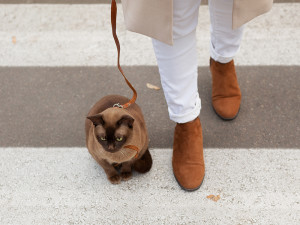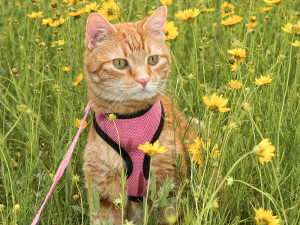Can Cats Find Their Way Home?
Thankfully, their natural instincts serve them well.

Share Article
In This Article:
How Cats Navigate Their Surroundings Reasons Why Cats Run Away or Leave Home What Factors Affect a Cat’s Ability to Find Their Way Home? What to Do If Your Cat Goes Missing Frequently Asked Questions
It’s natural to wonder how cats navigate and what their ability is to find their way back home if they get lost, especially if you’re considering letting them spend time outside or you’re taking your cat away from home and worrying they may escape. We know cats have some incredible instinctual skills. Let’s talk about how those skills help get your cat where they need to go.
How cats navigate their surroundings
As is often the case with cats, there’s a lot of mystery around their behaviors, including navigation. Scent can play a role, as can familiarity with the area. There’s also some research to suggest magnetic fields are a factor.
I’d venture to say their confidence levels also come into play, as a more nervous cat will be less likely to venture away from home or less willing to face a dangerous trek if they find themselves lost.

Natural homing instincts
Homing behavior is an animal’s inherent ability to navigate in the direction of an original location (such as their home or territory), passing through unfamiliar areas. For example, cats who make their way back to a previous home after a move or, in my case, many years ago, after escaping at the vet clinic, can often make it back home even if they don’t know the areas between where they are and where they want to end up.
How far can cats smell?
If your cat is lost, you might try putting out their favorite food to lure them back. But how far can that scent travel? There’s no single answer. It depends on many factors, like their breed, strength of the smell, other smells in the air, and wind direction. It’s thought that cats can smell food from around 120 to 150 feet away. It may not be enough to bring them home from three blocks over, but it might lure them down the street and back into your yard.
Cats also pick up on other smells in their territory and the areas they may travel outside that territory. This can help them navigate back to their starting point.
Visual landmarks and memory
Cats can see and have the capacity for learning. These undoubtedly play a role in helping them memorize their spaces and move through them.
Magnetic fields
It’s been suggested that cats and other animals have iron in their ears. This iron allows them to cue into the Earth's magnetic fields and use them as a directional device. Research suggests that’s why some animals naturally orient north/south.
Reasons why cats run away or leave home
There are many reasons a cat may leave their yard or the area right outside your home. Most are instinctual. But you can't discount people's influence.
Curiosity and exploration
Cats are explorers. It’s in their nature to check things out. If they’re hungry, they’ll head where the food is. Potential prey can lead them on a chase. They’ve also got great noses and may follow a scent to investigate it.
Mating instincts
Intact cats are highly influenced by their mating instincts. Females in heat may spray to spread their scent or get very vocal. Intact males can pick up on these signals from a mile away and leave their primary territory to reach the female.
Spayed and neutered cats can also be impacted by the mating instincts of intact cats. An intact male picking up on the location of a female in heat can be more aggressive and roam into other areas. Spayed and neutered cats may choose to keep their distance, possibly pushing them outside their usual territory and into areas where they aren't as comfortable or familiar.
Stress, fear, or changes in the environment
Cats are “fight or flight.” When faced with anything scary or dangerous (even perceived danger), they’re likely to get the heck out of there. This is where people and the environment can have a big impact. A noisy piece of equipment, construction in and around the home, fireworks, and landscaping that removes hiding spots like brush and shrubs are all disruptions that can force a cat out of their primary territory and often into unknown areas where they’re not as safe or likely to find their way back.
It can be physical changes, loud sounds, strangers, and don’t forget predators. It’s not uncommon for a mountain lion, hawk, or pack of coyotes, for example, to move into a new area and send the smaller animals that call that area home running for safer pastures. And, of course, people can be predators, too. Remember, not everyone loves cats the way we do.
Accidental displacement or getting lost
There are lots of accidental ways cats can get lost or simply not have a way home. They get curious, go looking for food, and may be avoiding predators.
Cats end up in vehicle engines, where they’re driven away from their homes. They can get locked in sheds and garages. People can take them in, thinking they’re lost. They may even make their way into shelters where, without proper identification, they may not make it home. It’s also common for cats to leave a new home and head back to their previous home.
What factors affect a cat’s ability to find their way home?
Just because your cat wants to go home doesn’t mean they’ll be able to. They may not be able to find their way or have the physical ability to get there.
How far away can a cat find their way back home?
A self-reported survey project by Lost Pet Researchopens in new tab between 2013 and 2018 suggests that the average distance lost cats traveled using their homing instincts was two to four miles. But some made it as far as 80 miles. There have even been reports of cats returning home years and hundreds of miles later (another reason why microchips are essential).
Unfamiliar or changed surroundings
While cats can use their homing instincts to navigate areas they don’t know well, it’s obviously more challenging to move through an unfamiliar area. If the area has changed over time — with new smells or physical obstacles like walls or waterways — a cat may have a harder time navigating.
Weather conditions (i.e., rain)
We all know how extreme weather can impact us. It can be just as bad, or worse, for our cats. Rain can wash away familiar scents that point the way home or cause flooding that blocks paths.
Extreme heat can lead to dehydration, heat exhaustion, burnt paws, and other physical issues. The more serious the weather event, the more dangerous and challenging it can be for your cat to find their way home and do so safely.
Health and age of the cat
A cat’s health is certainly a factor in their ability to find their way home. Any medical condition or limitation can throw a wrench in the works. Older cats are more prone to medical issues.
They may also experience changes in many of the skills that help cats navigate, like declining vision and hearing, becoming less sensitive to scent, or losing the mobility needed to cover the ground and avoid predators.
What to do if your cat goes missing
If your cat goes missing, it’s important to stay calm but act quickly. Do a thorough search of the area where your cat went missing. As we said before, leave out food that might lead them back home, and in the meantime, spread the word and contact the authorities.
FAQs (people also ask):
Why do cats leave home?
If your cat intentionally leaves home, it could be for a number of reasons. Most are based on their instincts. Following potential prey or an appealing scent or being driven away by something scary or dangerous are common reasons cats may leave their territory.
Do cats get lost?
Yes, cats can get lost. They have many tools to help them find their way home. But every cat and every situation is different, and it’s certainly possible for a cat to end up in a situation where they can’t get home.
References:
How Far Can A Male Cat Smell A Female In Heat – Vet Explains Petsopens in new tab
Cat Homing Behavior Survey Results - Lost Pet Research and Recoveryopens in new tab
How Far Can Cats Smell? The Secret Superpower Of Your Cat's Nose (rover.com)opens in new tab
The Science Behind Pets That Find Their Way Homeopens in new tab

LeeAnna Buis, CFTBS, FFCP
LeeAnna Buis has adored cats her entire life and thought she knew them inside out and sideways. But it wasn’t until she worked with a feline behavior consultant that she fully understood how incredible, complicated, and inspiring they really are. She made a career change, starting the certification process to become a behavior consultant right away. She discovered what unique, fascinating, complex creatures cats are and knew this was what she wanted to do with her life — help others on a similar journey to truly knowing, loving, and appreciating their cats.
LeeAnna earned her certification through Animal Behavior Institute, where she received the certified feline training and behavior specialist (CFTBS) designation.
Related articles
![adventure cat walking on a bridge in harness and leash]()
Could Your Cat Be an Adventure Cat?
How you can train your cat to explore the great outdoors.
![Cat sitting inside of a cat backpack]()
7 Best Cat Backpacks — Taylor Swift Would Approve
From futuristic space capsules to performance sportswear-style gear.
![A Burma breed cat on a leashed harness sitting near a feet of a girl at a pedestrian crossing.]()
How to Walk Your Cat on a Leash
Adventure Cats author Laura Moss’s step-by-step guide for hitting the streets with your cat.
![Cat sitting in a field wearing a pink harness and leash.]()
The Best Cat Harnesses of 2025
Safe and stylish gear to turn your local trail into a catwalk.
![A woman with tattoos with close shaved blonde hair wearing a tan sweater hugging her merle coat dog outside of a dog shelter]()
Lost Pets: How to Get Them Back
Find out what to do when your pet goes missing with these tips from a pet recovery expert.







